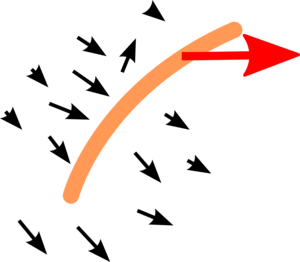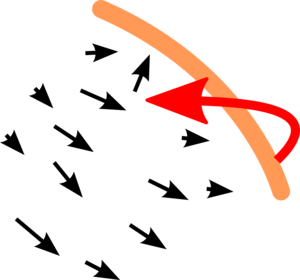Ingredients
There is an urban myth that 'science' says that a bee can't fly so we thought we should look into it. The story goes that a biologist and a Swiss aerodynamicist were having dinner and the biologist asked the engineer to work out if a bee should be able to fly. The engineer did some very simple calculations to see if a bee should be able to glide at the sorts of speeds it moves at, and the answer was no.
Bees can obviously fly, and you can use some very simple materials to find out some of the tricks a bee uses to fly. One of the most obvious ones is that the wing is beating all the time.
| Bee flying in slow motion - ultraslo.com |
If you look closely at the wing because it is flexible its angle changes as it changes direction.
It turns out that the flow around your hand in water is very similar to the flow of air around a bees wing so you can use it to model what is happening. So all you need is a hand, and a bath of water or possibly a pond.
Instructions
First try moving your hand through the water at an angle on long strokes - this is very like how a bird flies.
Now try lots of short strokes about 3-4 times the width of your hand, does it feel different?
Result
You should find that you can feel some lift with the long strokes, but not a huge amount.
| |
| Sculling with long strokes with your hand |
If you use very short strokes you should find that you get extra lift, particularly just after you change direction. The very high pressure under the wing (hand) often produces large splashes, and lots of lift.
| |
| Sculling with short strokes |
Explanation
A bee can obviously fly but the calculation by the engineer was correct, a plane the size and weight of a bee moving at the speed of a bee wouldn't be able to glide and would drop like a stone.
This sounds silly, but have you ever seen a bee gliding? If one tried to glide it would fall straight out of the sky. This is because fluids such as the air don't always behave the same. Fluid will flow around objects of the same shape, radically differently depending on whether the fluid's inertia, or their viscosity (gloopyness) is the most important.
Flows where the inertia is most important produces swirly turbulent flows like when smoke comes out of a chimney, and if viscosity is important then you get smooth slow flows like treacle from a spoon.
For a plane or a large bird inertia is by far the most important, and they get lift based on this. For a bee things get more interesting as the viscosity is starting to become important.
Bee tricks
The bee uses a few tricks to get around this. First, it flaps its wings which means they are moving through the air a lot faster than the bee is, but this still doesn't produce enough lift.
The bee's wings are at a much greater angle than an aircraft wing, this deflects the air downwards by a large amount, but it creates a vortex (tube of spinning air), producing a large wake, which uses lots of energy.
 |  |
| A conventional wing attempts to have a smooth airflow over and under it, which is deflected downwards by the wing, the equal and opposite reaction pushes the wing up. | At very high angles a leading edge vortex can form, this is not very efficient, but can produce extra lift. |
Another trick the bee uses is the one you should have noticed with your hand. When its wings change direction they hit their old wake, and convert some of the momentum of this moving air into extra lift, making the whole thing much more efficient.
 |  |
| If you look at the flow around a wing from a stationary point of view, lots of air is moving downwards, but it is also moving with the wing (because of the drag) forming a wake. | When the wing changes direction it can collide with this wake, converting energy in the wake into extra lift. |
So bees can fly and only very very simplified science says that they can't.
In fact this relates to how different types of bird fly. A large bird like a swan or goose flies very much like a plane, they only flap their wings to push themselves forwards, and the lift comes from moving through the air. As the bird gets smaller, gliding becomes less and less useful, with small birds like swifts and swallows actually folding their wings when they are not flapping. Very small birds like hummingbirds fly pretty much like a bee does.










Comments
Add a comment